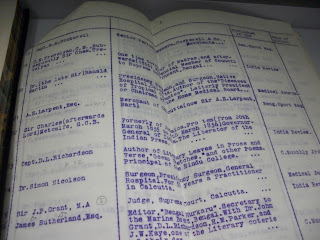This post by Dr John Cardwell first appeared in Cambridge University Library's
Special Collections blog, 6th December 2019. It has proved impossible to maintain the original layout and formatting.
 |
| Royal Tour of India, 1905-1906, RCMS 89_35_2_35 |
The Royal Commonwealth Society department has digitised a fascinating
series of scrapbooks documenting the Royal Visit to India in 1905-06 by the Prince and Princess of Wales, the future King George V and Queen Mary. Princess Mary possessed considerable intellectual curiosity, and as soon as the visit was announced, she began rigorous, systematic study in preparation. She read at least 36 books, and these were not simple tourist guides, but serious works of history and politics by experts on Indian affairs. This was balanced by research into India’s great ethnic, religious and cultural richness. Caring less about the experience of European residents, she was most intrigued to learn about the real lives of India’s peoples, and was especially fascinated by their religions. The map to the left emphasises the ambitious nature of the tour, which lasted roughly six months and covered vast distances by ship and rail, encompassing places as far apart as Bombay, Peshawar, Karachi and Rangoon. It was particularly demanding for Princess Mary, who had given birth to her sixth child, Prince John, only several months before.
 |
| Princess Mary reading on HMS Renown, 1905, QM 20 |
The success of Princess Mary’s programme of research is emphasised by the impression she made on the chief of staff for the 1905 tour, Sir Walter Lawrence, who had served as private secretary to the Viceroy Lord Curzon. During planning meetings he declared, ‘I consider you have a very good grasp on Indian affairs, quite remarkable in a woman.’ She later wrote to a friend from India, ‘I felt much flattered and repeat this for your ears only, as you know what trouble I took to get the right books’.
 |
| Pilgrim map of Benares, RCMS 89_35_3_36 |
 |
Song lyrics, RCMS 89_35_2_21
|
This foundation helped Queen Mary to make the most of what she saw, as she confided to the same friend, ‘The religions too, I know something of, Hindu, Mohammedan and Buddhism. All this knowledge, however small, helps one to take a keen interest in all one sees, and I therefore enjoy to the utmost every detail of the wonderful sights.’ George V ascended the throne in 1911, and the new king and queen returned in November for a grand coronation Durbar. Queen Mary prepared just as assiduously for her second visit, which deepened her understanding and admiration of India.
Queen Mary’s official biographer James Pope-Hennesy emphasised what an astounding revelation India was to her, ‘It stirred her emotionally, and it would be no exaggeration to say that Princess May fell in love with India. Ever afterwards a certain dreamy note would enter her voice when she spoke of India. “Lovely India, beautiful India,” she used to murmur like some incantation’. Queen Mary lovingly preserved a remarkable record of her two visits to India:
29 photograph albums containing approximately 3,800 images,
numerous printed books, many of which are presentation copies in special bindings from India’s ruling princes, as well as the scrapbooks of ephemera we’ve digitised, containing programmes of rail travel, receptions, military reviews, equestrian events, plans and orders of ceremonials, invitations, menus and guest lists.
 |
| Punjab Ball, RCMS 89_35_1_3 (artist: E.A.P. Hobday) |
 |
| RCMS 89_35_2_28 |
 |
| RCMS 89_35_3_5 |
 |
| RCMS 89_35_1_5 (artist: E.A.P. Hobday) |
After the death of her husband, Queen Mary presented her collection to the India Office Library in 1937. The independence and partition of India was very distressing to her, and she reacted with an allusion to Queen Mary Tudor and the loss of Calais, ‘When I die, India will be found written on my heart’. When it was proposed that the India Office Library should be divided between India and Pakistan, Queen Mary transferred her collection to the RCS in 1950. It came to Cambridge by purchase in 1993 along with the rest of the
RCS Library, after a public appeal raised sufficient funds to prevent its sale and dispersal. More digital images of this Royal Tour of India may be viewed on the
RCS Photograph Gallery.
 |
RCMS 89_35-3-31
|
 |
| Chappar Rift Bridge, Sind-Pishin Railway (photographer: Fred Bremner) |
 |
| Fruit market Quetta (photographer: Fred Bremner |
 |
| Group of Brahuis (photographer: Fred Bremner) |
























